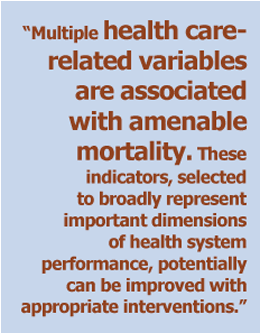Synopsis
A study of mortality amenable to health care in the United States shows a more than twofold variation in rates across the country. There are strong associations between state-level amenable mortality rates and demographic factors (e.g., poverty and race) and also to various health system-related indicators, like hospital readmission rates and care for diabetics and asthmatics.
The Issue
The statistic known as “mortality amenable to health care” or “amenable mortality” measures deaths from certain causes before age 75 that are potentially preventable with timely and effective health care. Researchers have used it to assess the performance of health systems of industrialized nations and to track changes over time. Previous studies have shown that the U.S. has failed to keep pace with rates of decline in amenable mortality in other countries. As of 2002–2003, the U.S. fell to last place out of 19 industrialized countries. In this study, authors led by former Commonwealth Fund executive vice president Stephen Schoenbaum examined the variation of amenable mortality across the U.S. and the extent to which this variation is associated with poverty and race, as well as other health system indicators.
Key Findings
- In 2004–2005, amenable mortality in the United States ranged from a low of 63.9 deaths per 100,000 people under age 75 in Minnesota to highs of 142.0 in Mississippi and 158.3 in the District of Columbia. Rates were highest in the southern states and in a band of states ranging from Texas to New York. The North Central, Mountain, and Pacific regions had lower rates (see exhibit).
- The variation in amenable mortality rates within the United States is more extensive than was observed in 19 industrialized countries in 2002–2003. A study of these 19 Organization for Economic Cooperation and Development (OECD) countries found a low of 65 in France and a high of 110 in the U.S.
- There are strong associations between amenable mortality and several health care measures that remain statistically significant after controlling for race and poverty. These indicators include: percentage of adult diabetics who received recommended preventive care; adult asthmatics with an emergency department or urgent care visit in the past year; hospital admissions of Medicare beneficiaries for ambulatory care–sensitive conditions; hospital readmissions of Medicare patients and of short-stay nursing home patients; and hospital admissions of long-stay nursing home patients.
Addressing the Problem 
Multiple health care indicators are associated with higher rates of mortality amenable to health care. As such, improving performance in these indicators (e.g., care for asthmatics or diabetics, hospital readmission rates) could help to improve amenable mortality rates, however the authors warn there is as yet no evidence. It is a hypothesis worth testing, the authors state, adding that “improvement in variables such as readmission rates or care for asthmatics or diabetics are objectives worth attaining in their own right.” All states—regardless of starting point—can work to improve their health system performance and the health of their residents.
About the Study
The authors calculated rates of mortality amenable to health care for each state and the District of Columbia using Centers for Disease Control and Prevention data. Other variables, including the percentage of each state population that is black, the percentage with household incomes under 200 percent of the federal poverty level, and 19 health care access and system performance indicators, were originally compiled for The Commonwealth Fund’s 2009 state scorecard on health system performance.
The Bottom Line
There is a more than twofold variation in rates of mortality amenable to health care across the United States, with strong associations between state-level amenable mortality rates and poverty and race, and with indicators including hospital readmission rates and care for diabetics and asthmatics.